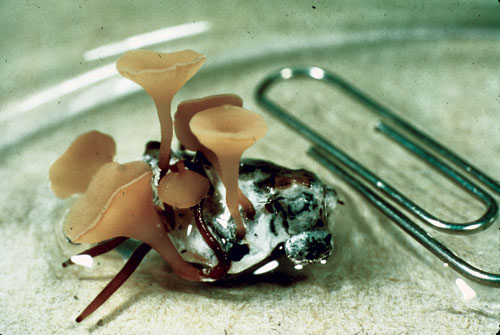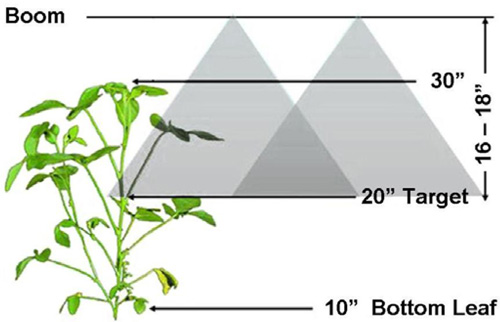Applying foliar fungicides for control of white mold in soybeans
Is a foliar fungicide application for white mold warranted and will it increase the level of white mold control when fungicides are applied?
There is increasing interest in applying foliar fungicides to manage white mold (Sclerotinia stem rot) in soybeans. This practice may be warranted in fields that have a history of white mold and when conditions occurring in the field are conducive to white mold development. Past research has shown that complete control of white mold with fungicides is not possible. In these trials, the reduction in white mold incidence from fungicide applications has ranged from 0 to 60 percent. Therefore, chemical control should be combined with other white mold strategies including cultural control, use of tolerant varieties, irrigation water management and biological control.
Producers should be familiar with the white mold disease cycle before considering a fungicide application to control the disease. This will help them determine if white mold is likely to occur before applying the fungicide.
The disease cycle begins with the sclerotia - black, reproductive structure produced during a previous infection that can survive in the soil for three to five years. When the soil has been continuously moist for 10 to 14 days, apothecia develop from the sclerotia (Photo 1) and release ascospores into the air. Susceptible soybean varieties are the most vulnerable to infection between R1 and R3 when the ascospores colonize the senescing flowers. Temperatures below 85 degrees Fahrenheit and conditions causing leaf wetness periods of 12 to 16 hours are necessary for successful colonization of the flowers. Once the flowers are colonized, the infection can spread down the stem, beginning at the node bearing the colonized flower.

Photo 1. Apothecia forming on sclerotia. Photo credit: Dr. Jim Venette, North Dakota State University
Dense soybean canopies favor the development of white mold by shading the soil and keeping it moist, which encourages apothecia formation, and by maintaining leaf wetness in the lower canopy. Irrigation water applications before and during flowering can also encourage white mold development. If the potential for white mold is high and the field has been previously infected with white mold, a fungicide application may be warranted.
Two factors determine the success of any fungicide application for white mold: proper timing and adequate coverage. The best time to apply fungicides for white mold control is R1 (first flower). Applications made at R3 (beginning pod) have provided a lower level of control and applications made after disease symptoms are visible are not effective and should be avoided.
Adequate coverage is essential as the fungicide must reach and cover the flowers deep in the crop canopy to be effective. This presents a challenge to applicators as white mold is typically a problem in dense crop canopies. Producers will need to equip and operate their sprayers properly to achieve adequate canopy penetration and coverage. The following recommendations will improve fungicide penetration into the canopy and deposition on the flowers:
- Increase spray volume to 15 to 20 gallons per acre.
- Keep groundspeeds below 10 miles per hour.
- Maintain nozzle pressures around 40 psi.
- Select flat fan nozzles that produce fine to medium droplets (volume median diameters of 200 to 350 microns) under the conditions stated in 1-3 above.
- Set the boom at the correct height (Figure 1).
Figure 1. Recommended boom height for 110 degree flat fan nozzles spaced
20 inches apart when applying insecticides and fungicides in 30-inch tall soybeans.

A more detailed explanation of equipping and operating sprayers for fungicide applications is available in the MSU Extension article Equipping and operating sprayers to control insects and diseases in soybean.
Table 1. Products registered for white mold in soybeans
|
Product name |
Application rate per acre |
|
Topsin M 70 WP or 70 WDG |
12 to 16 oz |
|
Topsin 4.5 FL |
15 to 20 oz |
|
Thiophanate Methyl 85 WDG |
9.6 to 12.8 oz |
|
Endura |
5.5 to 11 oz |
|
Domark 230 ME |
4 to 5 oz |
|
Cobra |
6.8 oz |
|
Proline 480 SC |
3 to 4.3 oz |
|
*Topguard |
7 to 14 oz |
* Field corn, sweet corn, seed corn or soybeans must be planted in the field the following spring.
This article was produced by the SMaRT project (Soybean Management and Research Technology). The SMaRT project was developed to help Michigan producers increase soybean yields and farm profitability. SMaRT is a partnership between MSU Extension and the Michigan Soybean Checkoff program.
References:
- Sclerotinia stem rot of soybean, identification, factors and management, Martin Chilvers, Michigan State University.
- Esker, P., Peltier, A., Bradley, C., Chilvers, M., Malvick, D., Mueller, D., and Wise, K. 2011. Management of white mold in soybean. North Central Soybean Research Program – Plant Health Initiative, booklet.
- Brown-Rytlewski, D., Staton, M., DiFonzo, C., 2011. Pesticide application technology for soybean rust and soybean aphids. SMaRT (Soybean Management and Research Technology) Soybean Facts factsheet.



 Print
Print Email
Email

